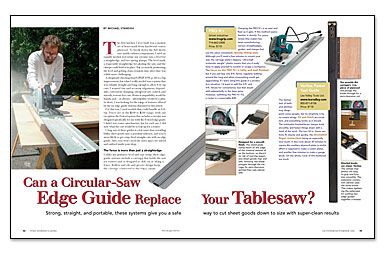Can a Circular-Saw Edge Guide Replace Your Tablesaw?
These systems offer a safe, precise way to cut sheet goods.

Synopsis: Finish carpenter Michael Standish takes a look at six brands of edge guides. With proper setup, an edge-guide system for a circular saw can be a viable alternative to a tablesaw and can even be adapted for router use. Portability makes edge guides a good option for job-site use. Tools tested are the PRO ft’r, Veritas Power Tool Guide, EZ Smart Guide System, Tool Trolley, Red-Line Cutting Guide, and Festool Guide Rail and Saw.
The first kitchen I ever built was a modest set of boxes made from hardwood-veneer plywood. To break down the 4×8 sheets into usable cabinet components, I used an equally modest tool setup: my circular saw, a level for a straightedge, and two spring clamps. The level made a respectable straightedge for guiding the saw, and the clamps could hold it in place. But accurately positioning the level and getting clean crosscuts time after time was a little more challenging.
A shopmade shooting board is a big improvement, but what I really needed was a system that was reliably straight and long enough to allow 8-ft. rip cuts. I wanted fast and accurate alignment; dependable, convenient clamping; idiotproof saw control; and smooth, tearout-free cuts. Router compatibility would be handy, and—as always—affordability would be a plus. In short, I was looking for the range of features offered by the six edge-guide systems discussed in this article.
For this test, I used models that could handle an 8-ft. rip. Prices are in the $100 to $200 range, with one exception: the Festool system that includes a circular saw designed specifically for use with the Festool edge guide. I didn’t test router attachments, but for each one, I did note what the cost would be to tool up for a router.
Using any of these guides is a lot easier than wrestling bulky sheet goods onto a portable tablesaw, and you’re more likely to get crisp, dead-straight cuts with an edge guide. Also, you won’t need the extra space for infeed and outfeed inside your shop.
The fence is more than just a straightedge
Unlike my primitive level-and-saw setup, these edge-guide systems include a carriage that holds the saw (or router) and is designed to ride on or along a fence. Rollers and rib-and-groove design keep the carriage connected to the fence, ensuring a straight ride. Clamps hold the fence in place on the workpiece.
The fences for all the systems I tested are made of anodized aluminum, in one of three configurations. The EZ Smart, the Festool, and the PRO ft’r use comparatively thin-walled extrusions, with integral ribs for rigidity. Red-Line and Veritas are essentially heavy I-beams, while the Tool Trolley uses angle stock. All these approaches result in stiff, flex-free straightedges.
Most manufacturers make sections (good for 4-ft. cuts) that can be linked together for cuts of 6 ft., 8 ft., or longer. Festool and PRO ft’r offer various dedicated single lengths from just more than 2 ft. to just more than 8 ft. (Festool has even longer fences). While longer fences are simpler and faster for lengthwise rip cuts, dodging their overhang can become tiresome when crosscutting, and they’re less convenient to transport and store.
Aligning the EZ Smart and Festool fences couldn’t be easier: Set the edge of the fence on the cutline, clamp, and cut. For the other guides in this survey, you need to know the distance from the edge of the fence to the sawblade. Once this offset has been established, the best plan is to make a gauge block. You still need to strike the correct line and mark the setback before you can place and clamp the fence, but it’s much quicker and less error-prone than remeasuring with a tape.
For more photos and details, click the View PDF button below:
Fine Homebuilding Recommended Products
Fine Homebuilding receives a commission for items purchased through links on this site, including Amazon Associates and other affiliate advertising programs.

All New Kitchen Ideas that Work

Homebody: A Guide to Creating Spaces You Never Want to Leave

A House Needs to Breathe...Or Does It?: An Introduction to Building Science


























